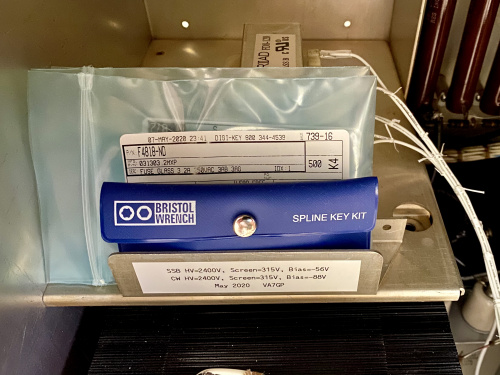Operation: Difference between revisions
No edit summary |
|||
| Line 22: | Line 22: | ||
=Contests: SSB and CW= |
=Contests: SSB and CW= |
||
I (casually!) entered Field Day 2020, and gave my newly-renovated 30S-1 a weekend shake-down run. To jump between modes, I left the 30S-1 in "SSB" mode - this meant I always had idling-current, and did not operate the amp in Class C for CW. The penalty: higher heat dissipation. The benefit: one less thing to think about. |
I (casually!) entered Field Day 2020, and gave my newly-renovated 30S-1 a weekend shake-down run. To jump between modes, I left the 30S-1 in "SSB" mode - this meant I always had idling-current, and did not operate the amp in Class C for CW. The penalty: higher heat dissipation. The benefit: one less thing to think about. |
||
=Tuning= |
|||
How often? How to tune? |
|||
My personal answer to "How Often" revolves around changes in frequency: I feel I must retune if I change by 50kHz on 20-15-10, and every ~25kHz on 40-80. Beware - I view these as maximum (contest) changes in frequency, where the amp will become a bit stressed (higher dissipation), but not unduly. If things are slow, I may re-tweak much more-often... maybe every few kHz :-) |
|||
There is a second answer too, involving changes in power, but it's less-common. If the power-level is changed - 25% might be good guidance - then the (Plate Voltage) / (Plate Current) impedance changes, and the Pi-output network will need adjustment too - if only for the proper impedance transformation, supposing resonance isn't greatly affected. |
|||
Revision as of 18:37, 28 November 2020
Dayton Blower Sound Level
Here is a video-clip to provide an idea of the blower-noise after changing the motor to the 3,000rpm Dayton 4M093E. For context I provide a brief introduction with my voice, and I have my receiver on. I used the NIOSH iOS app to obtain these measurements, before we get to the video:
- 30S-1 with Dayton 3,000rpm motor change: 59 dB(A) 1-meter directly in front
- Listening to HF Radio, SSB voice: 65 dB(A) for my preferred Sound Level
- My living-room is a blissful 36 dB(A)
Video - Dayton Blower Start-up and Sound Level
Dial Lights After Warm-Up
The 30S-1 amplifier was designed with a 3-min delay before allowing High Voltage on the tube - the Eimac datasheet specifies at least this long. Mine is closer to 2-1/2 minutes, so I must pause before pushing the "ON" button. To let me know when this time-delay has completed, I re-wired my dial-lights to the DC circuit which is down-wind of the thermal delay-timer; the dial-lights will only turn on after the time-delay.
- remove the hot lead from lamp socket DS201
- Add a new lead from DS201 to the white-red-orange-green wire at the rear of the HV "OFF" switch, S208 (either contact)
Here is a 10-second video clip showing the dial-lights illuminating, after the time-delay:
Video - Dial Lights after Warm-Up
Spares and Servicing
I use the Power Supply Shelf for storing 2 sets of spare fuses, and a set of Bristol wrenches:
Contests: SSB and CW
I (casually!) entered Field Day 2020, and gave my newly-renovated 30S-1 a weekend shake-down run. To jump between modes, I left the 30S-1 in "SSB" mode - this meant I always had idling-current, and did not operate the amp in Class C for CW. The penalty: higher heat dissipation. The benefit: one less thing to think about.
Tuning
How often? How to tune?
My personal answer to "How Often" revolves around changes in frequency: I feel I must retune if I change by 50kHz on 20-15-10, and every ~25kHz on 40-80. Beware - I view these as maximum (contest) changes in frequency, where the amp will become a bit stressed (higher dissipation), but not unduly. If things are slow, I may re-tweak much more-often... maybe every few kHz :-)
There is a second answer too, involving changes in power, but it's less-common. If the power-level is changed - 25% might be good guidance - then the (Plate Voltage) / (Plate Current) impedance changes, and the Pi-output network will need adjustment too - if only for the proper impedance transformation, supposing resonance isn't greatly affected.
